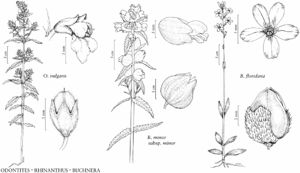Difference between revisions of "Buchnera floridana"
Bull. Soc. Bot. France 66: 217. 1919.
FNA>Volume Importer |
FNA>Volume Importer |
||
| Line 31: | Line 31: | ||
|elevation=0–150 m. | |elevation=0–150 m. | ||
|distribution=Ala.;Ark.;Fla.;Ga.;La.;Miss.;N.C.;S.C.;Tex.;Mexico (Yucatán);West Indies (Bahamas;Cuba;Dominican Republic;Jamaica);Central America (Belize). | |distribution=Ala.;Ark.;Fla.;Ga.;La.;Miss.;N.C.;S.C.;Tex.;Mexico (Yucatán);West Indies (Bahamas;Cuba;Dominican Republic;Jamaica);Central America (Belize). | ||
| − | |discussion=<p>Buchnera floridana is mostly restricted to the Coastal Plain, occurring primarily in fire-maintained, pine-graminoid ecosystems in strongly acidic soils. Collections also have been made from higher pH soils of chalk prairies in Alabama and Mississippi and from limestone substrates in Florida and Texas; in the Caribbean, it regularly occurs in limestone soils. The situation in Texas is unusual in that B. floridana occurs far inland as well as on the Coastal Plain; most Texas specimens of Buchnera belong to B. floridana; B. americana is known from counties along the Red River and in the pinelands of eastern Texas.</p><!-- | + | |discussion=<p><i>Buchnera floridana</i> is mostly restricted to the Coastal Plain, occurring primarily in fire-maintained, pine-graminoid ecosystems in strongly acidic soils. Collections also have been made from higher pH soils of chalk prairies in Alabama and Mississippi and from limestone substrates in Florida and Texas; in the Caribbean, it regularly occurs in limestone soils. The situation in Texas is unusual in that <i>B. floridana</i> occurs far inland as well as on the Coastal Plain; most Texas specimens of <i>Buchnera</i> belong to <i>B. floridana</i>; <i>B. americana</i> is known from counties along the Red River and in the pinelands of eastern Texas.</p><!-- |
| − | --><p>Some specimens of Buchnera floridana from southern Florida and the Keys have slender leaves and reduced indument on the calyx, which are typical of B. longifolia Kunth (= B. elongata Swartz; both names have been applied to Florida plants) of the Caribbean, Central America, and South America; they lack the glabrous corollas, long calyces, and large inflorescence bracts of B. longifolia. The presence of one or more B. longifolia characteristics in southern Florida plants may be the result of past contact between the two species; there is no evidence that the two come into contact in Florida at present.</p> | + | --><p>Some specimens of <i>Buchnera floridana</i> from southern Florida and the Keys have slender leaves and reduced indument on the calyx, which are typical of <i>B. longifolia</i> Kunth (= <i>B. elongata</i> Swartz; both names have been applied to Florida plants) of the Caribbean, Central America, and South America; they lack the glabrous corollas, long calyces, and large inflorescence bracts of <i>B. longifolia</i>. The presence of one or more <i>B. longifolia</i> characteristics in southern Florida plants may be the result of past contact between the two species; there is no evidence that the two come into contact in Florida at present.</p> |
|tables= | |tables= | ||
|references= | |references= | ||
| Line 56: | Line 56: | ||
|publication year=1919 | |publication year=1919 | ||
|special status=Selected by author to be illustrated | |special status=Selected by author to be illustrated | ||
| − | |source xml=https://jpend@bitbucket.org/aafc-mbb/fna-data-curation.git/src/ | + | |source xml=https://jpend@bitbucket.org/aafc-mbb/fna-data-curation.git/src/8f726806613d60c220dc4493de13607dd3150896/coarse_grained_fna_xml/V17/V17_877.xml |
|genus=Buchnera | |genus=Buchnera | ||
|species=Buchnera floridana | |species=Buchnera floridana | ||
Revision as of 16:04, 18 September 2019
Biennials; blackening upon drying. Stems simple or branched distally, 2–8 dm, appressed-hirsute or spreading-hirsute proximally, appressed-hirsute or glabrous distally. Leaves much smaller distally; larger blade: major vein 1, minor veins (0–)2, narrowly oblanceolate, lanceolate, or broadly linear, 25–60 x 3–12 mm, margins entire or crenate, teeth 0.5–1.5 mm, apex obtuse or rounded, sometimes acute, surfaces glabrate or appressed-pilose. Spikes: bracts ovate-lanceolate, 1.5–4 mm. Pedicels 0.5–1 mm; bracteoles 1–2 mm. Flowers: calyx 4.5–5.5 mm, tube obscurely 10-nerved, ascending- to appressed-hispid, hairs often pustular-based; corolla 10–16 mm, glabrate externally, lobes 2–5 mm; style included, 1–2 mm. Capsules blackish, ovoid, 4.5–6.5 mm, glabrate. Seeds 0.5–0.7 mm.
Phenology: Flowering May–Oct.
Habitat: Moist pine savannas, flatwoods, streamhead ecotones, seepage slopes, pitcher-plant bogs.
Elevation: 0–150 m.
Distribution
Ala., Ark., Fla., Ga., La., Miss., N.C., S.C., Tex., Mexico (Yucatán), West Indies (Bahamas, Cuba, Dominican Republic, Jamaica), Central America (Belize).
Discussion
Buchnera floridana is mostly restricted to the Coastal Plain, occurring primarily in fire-maintained, pine-graminoid ecosystems in strongly acidic soils. Collections also have been made from higher pH soils of chalk prairies in Alabama and Mississippi and from limestone substrates in Florida and Texas; in the Caribbean, it regularly occurs in limestone soils. The situation in Texas is unusual in that B. floridana occurs far inland as well as on the Coastal Plain; most Texas specimens of Buchnera belong to B. floridana; B. americana is known from counties along the Red River and in the pinelands of eastern Texas.
Some specimens of Buchnera floridana from southern Florida and the Keys have slender leaves and reduced indument on the calyx, which are typical of B. longifolia Kunth (= B. elongata Swartz; both names have been applied to Florida plants) of the Caribbean, Central America, and South America; they lack the glabrous corollas, long calyces, and large inflorescence bracts of B. longifolia. The presence of one or more B. longifolia characteristics in southern Florida plants may be the result of past contact between the two species; there is no evidence that the two come into contact in Florida at present.
Selected References
None.
